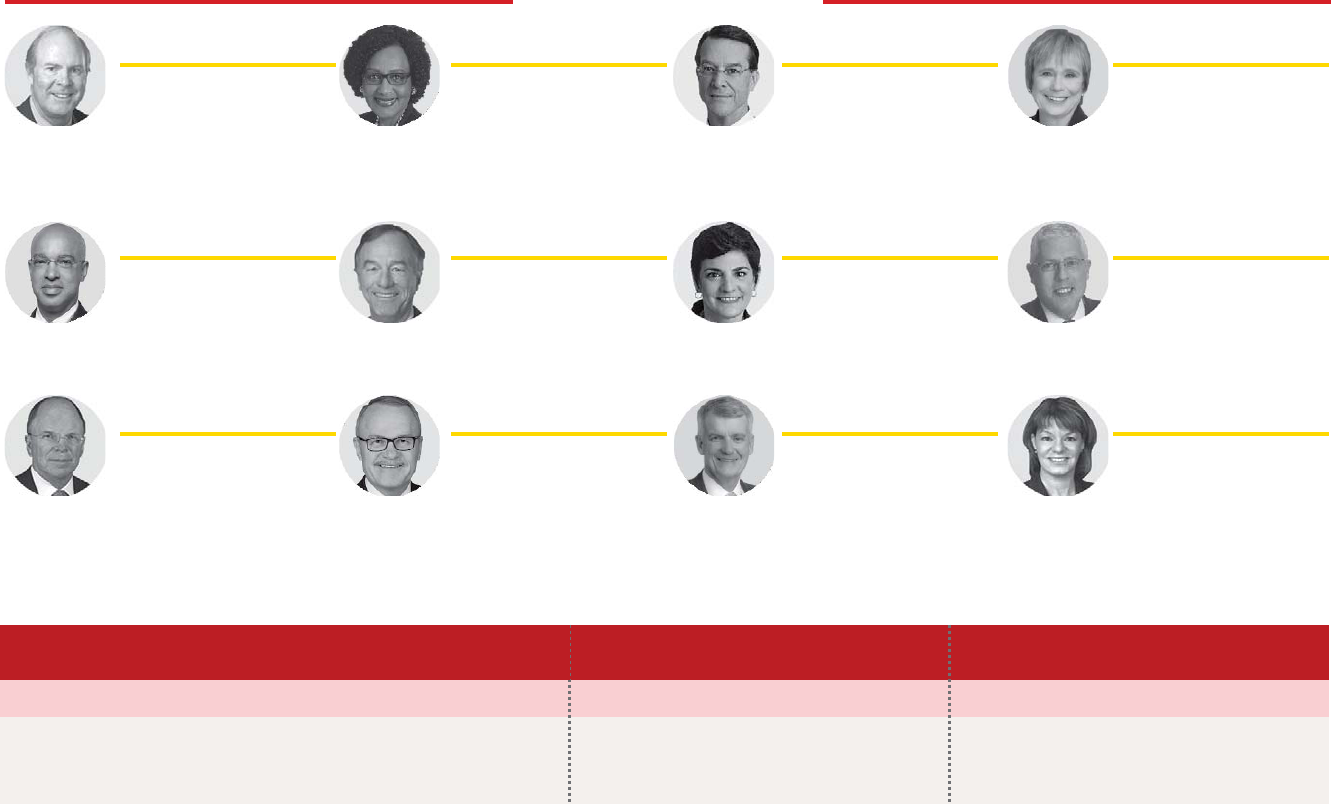
Wells Fargo –
Transforming for the Future
March 2019
© 2019 Wells Fargo Bank, N.A. All rights reserved.

Our Vision We want to satisfy our
customers’ financial needs
and help them succeed financially.
The Vision,
Values &
Goals of
Wells Fargo
Our Values
What’s right for customers
People as a competitive advantage
Ethics
Diversity and inclusion
Leadership
Our Goals
We want to become the financial services leader
in these areas:
Customer Team Innovation
service and member
advice
engagement
Risk Corporate Shareholder
management citizenship value
2

Our Business, Strategy, and Goals
Wells Fargo is a diversified, community-based financial services company, with $1.9 trillion in assets and
approximately 260,000 team members working to serve one in three households in the United States.
Primary Business Groups
Consumer Banking
• Community Banking
• Home Lending
• Auto
•
Personal Lending and Small Business
Payments, Virtual Solutions, Wealth and Investment
and Innovation (PVSI) Management
•
•
•
•
•
•
Payments businesses and deposit
products
Credit Cards
Virtual Channels
Operations
Innovation
Merchant Services
•
•
•
•
•
•
Wells Fargo Advisors
Institutional Retirement and Trust
Asset Management
Private Bank
Abbot Downing
Wells Fargo Investment Institute
Wholesale Banking
• Commercial Banking
• Commercial Capital
• Commercial Real Estate
• Corporate and Investment Banking
• Investment Portfolio
• Delivering excellent customer experiences
through collaborating across business lines
• Becoming more customer-centric
• Simplifying our businesses and offerings
• Improving operational excellence
• Strengthening our risk oversight and controls
Our ability to sustain solid financial performance
in the face of recent challenges is a testament to
the financial durability provided by our core
franchise and diversified business model.
Key Components of Our Enterprise Strategy
Making Progress on Our Six Goals
• Customer Service and Advice: Retail banking customer experience scores
for “Customer Loyalty” and “Overall Satisfaction with Most Recent Visit”
reached a 24-month high in December 2018
• Team Member Engagement: In 2018, voluntary team member attrition
improved to its lowest level in six years
• Innovation: Creating digital account opening experience for many products,
enhancing payments capabilities, and building capabilities and technologies
that enable innovation; introduced customer-friendly services, including
real-time balance alerts and Overdraft Rewind® to help our customers
• Risk Management: Introduced an updated and expanded risk management
framework and focused on multiple transformative risk initiatives
• Corporate Citizenship: Donated $444 million to nearly 11,000 nonprofits,
surpassing our 2018 target of $400 million
• Shareholder Value: For 2018, record diluted earnings per common share;
higher return on assets and return on equity (both up from 2017);
continued to return significant capital to shareholders
3

Diverse and Skilled Director Nominees
Our director nominees represent a highly qualified and diverse mix of directors who bring qualifications,
skills, and experience relevant to Wells Fargo’s business, strategy, risk profile, and risk appetite.
Director Nominees
John D. Baker II Celeste A. Clark Theodore F. Craver, Jr. Elizabeth A. (“Betsy”) Duke
Executive Chairman Principal, Abraham Clark Retired Chairman, President, Independent Chair
and CEO, FRP Consulting, LLC; retired Sr. VP, and CEO, Edison
Former member of the
Holdings,Inc. Global Public Policy and International
Federal Reserve Board of
External Relations, and Chief
Committees: AEC, CC* Committees: AEC, FC*
Governors
Sustainability Officer, Kellogg
Company
Committees: CC, FC, GNC,RC
Committees: CRC*, CC, GNC
Wayne M. Hewett Donald M. James Maria R. Morris Juan A. Pujadas
Senior Advisor, Retired Chairman and Retired Executive Vice Retired Principal,
Permira; Chairman, CEO, Vulcan Materials President and head of PricewaterhouseCoopers
DiversiTech Company Global Employee Benefits LLP, and former Vice
Corporation business, MetLife, Inc. Chairman, Global Advisory
Committees: FC, GNC*,
Services,PwC Intl.
Committees: CRC, HRC, RC HRC Committees: HRC, RC*
Committees: CC, FC, RC
James H. Quigley Ronald L. Sargent Timothy J.Sloan Suzanne M. Vautrinot
CEO Emeritus and a Retired Chairman and CEO and President, President, Kilovolt Consulting
retired Partner of CEO, Staples, Inc. Wells Fargo & Inc.; Major General (retired),
Deloitte Company U.S. Air Force
Committees: AEC, CRC, GNC,
Committees: AEC*, RC HRC* Committees: None Committees: CRC, CC, RC
AEC Audit and Examination Committee FC Finance Committee HRC Human Resources Committee
CRC Corporate Responsibility Committee GNC Governance and Nominating Committee RC Risk Committee
CC Credit Committee
* Committee Chair
42% 67% 33% 25% 33% 55% 3.5 years
of director
nominees have
financial services
experience
of director
nominees
have risk
management
experience
of director
nominees have
human capital
management
experience
of director
nominees are
racially / ethnically
diverse
of director
nominees are
women
of independent
director nominees
elected since Jan.
2017
average tenure* of
independent
director nominees
*
Based on completed years of service from date first elected to the Board.
As previously disclosed, Karen B. Peetz, a current director, will retire as a director at the Company’s 2019 annual meeting of shareholders.
Director Skillsets Align with our Strategy, Risk Profile,
and Focus on our Vision, Values & Goals
Board is Diverse
in Backgrounds and Experiences
Commitment to Refreshment
Ensures Fresh Perspectives
4

Board-led Engagement Informs Governance Enhancements
Over the past two years, the Board has made changes to enhance its composition, oversight, and
governance practices which were informed by the Board’s comprehensive self-evaluation of Board
performance and effectiveness and feedback provided by our investors and other stakeholders.
Over 25 engagement meetings
held with institutional investors
with Board Chair participation
since 2018 annual meeting
Governance Practices
• Board engaged a third party to
facilitate its 2018 and 2017 Board
self-evaluations
• Enhanced director onboarding,
director recruitmentand
nomination, and Board succession
planning processes
• Enhanced existing shareholder
right to call a special meeting
• Enhanced Corporate Governance
Guidelines, including to more fully
articulate the role of the Board,
reflect the independent Chair
leadership structure, and
implement an overboarding policy
• Held meetings with external
Stakeholder Advisory Council
which was formed in Dec. 2017
Over 50 engagement meetings
held with institutional investors
since 2018 annual meeting
Board-led engagement program conducted year round
Enhanced Disclosures
• Published our Business Standards
Report in Jan. 2019
• Significantly enhanced disclosure
about our human capital
management, culture, and
performance management
program and compensation
practices in our proxy statements
• Disclosed our Company’s gender
and racial/ethnic pay gaps and
additional metrics on the
representation of women and
people of color in senior leadership
• Enhanced Board experience matrix
in proxy statement to include
diversity information
Met with investors
representing more than 35%
of shares outstanding
Board Composition and Leadership
• Significant Board refreshment,
with a majority of independent
director nominees having joined
the Board since Jan. 2017
• Separated the roles of Chair and
CEO in 2016
• Since 2017 annual meeting, six of
seven standing Board committees
have new committee chairs
• Enhanced skills and experiences
represented on Board, including
financials services, risk
management, information
security/cyber, technology,
regulatory, human capital
management, finance, consumer,
business process and operations,
and social responsibility experience
5

Board Priorities
The Board is focused on making progress across key priorities as we work to transform Wells Fargo, meet
the expectations of our regulators, and rebuild trust with our stakeholders.
Meeting Regulatory
Expectations
• Satisfying regulatory expectations and the requirements of the Company’s outstanding consent orders with its regulators
• Enhancing our risk and reporting systems to meet the heightened regulatory expectations for systemically important
financial institutions and our own goal of industry leadership in risk management
• Engaging in frequent and open communication with our regulators about our progress
Enhancing Risk
Management
• Remaining an industry leader in credit, market, and liquidity risk management
• Improving the Company’s risk management program
• Implementing plans to continue building our operational and compliance risk management systems to a level that matches
our business, structure, and strategies
• Enhancing management-level governance committee structures, oversight, monitoring and controls, and escalation
processes and procedures
Operational Excellence
• Strengthening operations across the organization, including progress on the Company’s project to inventory and map all of
our business processes
• Improving control testing and monitoring functions and reducing the number and complexity of our business processes in
order to offer the potential for improving the efficiency and effectiveness of core operations
Oversight of Culture and
• Continuing to assess and shape the Company’s culture with an emphasis on ethics, training and development, and diversity
Human Capital
and inclusion
Management
• Focusing on human capital management practices, including talent management strategies such as plans to attract, retain,
reward, develop, and care for the best talent
Technology
• Consistent with the Company’s consumer strategy, meeting the needs of our customers by collaborating across businesses
to provide offerings that allow customers to engage with us how, when, and where they choose
• Making sure all of our systems operate on up-to-date platforms, are able to process and protect massive amounts of data,
and contribute to our vision of operational excellence and leadership in innovation
Agenda Planning and Information Flow to the Board
• In addition to enhancing its corporate governance framework, the Board and management continue to improve information flow, escalation of matters, and
reporting and analysis provided to the Board.
• Board Chair is actively managing Board agendas to provide sufficient time for key business, strategy, risk, culture, and other discussions, and additional time for
Board focus on strategic planning, risk appetite alignment, and talent planning. For example, a two-day strategy review session was added to Board schedule
beginning in 2018.
6

Culture and Human Capital Management
Our Board and its Human Resources Committee oversee our efforts to strengthen and monitor our culture.
In 2018, we introduced new behavioral expectations for all team members through a common leadership
objective, with additional leadership expectations for managers.
What We Say How We Behave
Visions, Values & Goals Expectations and accountability for all team members
What’s right for customers • Act with integrity and always do the right thing for the customer
• Listen to all customers, anticipate their unique needs, and work in
partnership to achieve their goals
• Build trust and long-term relationships
People as a competitive
advantage
• Encourage well-being and celebratesuccess
• Recognize and leverage each other’s contributions and talents
• Share best practices and embrace new ideas together
• Develop yourself and others
Ethics • Know what’s right and do what’s right; if you don’t know, ask
• Raise concerns and escalate early
• Take accountability for all actions and decisions made
• Be open, honest, and transparent
Diversity and inclusion • Make sure that people feel included, valued, supported, and heard
• Recognize and address your own biases
• Seek, accept, and encourage diversity ofpeople and thought
Leadership • Inspire, engage, influence, and lead by example
• Proactively seek, give, and apply feedback
• Engage in courageous conversations
• Make decisions with a One Wells Fargo view
Wells Fargo Culture
Actions taken to listen to and invest in our team
members
• Expanded and continued team member listening program,
which monitors team member engagement and experience
via assessments, surveys, and establishing a two-way
dialogue between executives and team members
• Invested in our team members by ggranting restricted share
rights to approximately 250,000 team members, rraising the
minimum hourly wage
1
to $15, iincreasing the number of paid
holidays
1
, and iinvesting approximately $13,000 per team
member in our benefit programs each year
• Promoting diversity and inclusion through ssourcing diverse
talent, bbuilding a diverse pipeline of candidates, and pproviding
development and mentoring opportunities for team
members of all diversity dimensions
Measuring progress
• In 2018, voluntary team member attrition improved to its
lowest level in six years
• More than 75% of team members have actively participated
in a company-wide survey since 2016
• More than 4,000 exit surveys conducted and analyzed
• Behavioral expectations aligned with our Vision, Values &
Goals implemented for all team members in 2018
We have made strong progress in building the kind of culture that our team members expect and deserve.
We will assess the many practices put in place over the past two years and continue to enhance them.
See the Human Capital Management section beginning on page 62 of our Company’s 2019 proxy statement for more information.
1
Increases in minimum hourly pay and additional paid holidays were for U.S.-based team members.
7

Business Standards Report – “Learning from the Past, Transforming for
the Future”
Wells Fargo issued its Business Standards Report in January 2019 as part of our commitment to
transparency and ongoing work to rebuild trust with stakeholders.
Included in Report
• Chapters representing key focus
areas for our company:
‒ Culture
‒ Company goals
‒ Leadership/corporate
governance
‒ Risk management
‒ Stakeholder relationships
• Case studies
‒ Examples of business practices
including many informed by
lessons learned from our past
• The Business Standards Report, “Learning from the past, transforming for the future,”
summarizes much of what we’ve done over the past two years to address past issues and provides
updates on our businesses, practices, and progress on our six goals as we transform our Company
• Outlines actions the Company has taken and continues to take to:
• Improve our culture
• Make things right for customers who were harmed
• Reconstitute our organizational structure
• Strengthen risk management and controls
• This report was developed in response to a shareholder proposal received for inclusion in the
Company’s 2018 proxy statement from a group of shareholders led by the Interfaith Center on
Corporate Responsibility (ICCR)
• Involved more than 175 leaders and team members and was guided and overseen by our Board,
our CEO, and our Operating Committee, which consists of executives reporting directly to our
CEO
Press Release
https://newsroom.wf.com/press-release/corporate-and-financial/wells-fargo-issues-
business-standards-report
Business Standards Report Webpage
https://www.wellsfargo.com/about/corporate/governance/business-standards-report/
We thank ICCR and other key stakeholders, including team members, customers, and our
external Stakeholder Advisory Council, for their contributions to this report.
8

2018 Executive Compensation Program Overview
Compensation program reflects our compensation principles: Pay for Performance; Attract and Retain Top
Executive Talent; Foster Risk Management Culture; and Encourage Long-Term Shareholder Value Creation.
Pay Element 2018 Form Key Metrics Purpose
Base Salary Cash Fixed • Fixed compensation reflecting
experience and responsibility
Annual Cash • Based on performance objective framework that • Rewards Company performance,
Incentive focuses on pre-established objectives that include business line performance, risk
Award expectations for both “what” is achieved and “how” it is management, effective
achieved (see next slide for more detail on framework) management, leadership, and risk
accountability
• May be earned from zero to 150% of annual base salary
(except for the CEO, who does not have a target
amount)
Long-Term Performance • Performance Shares establish direct link to Company • Aligns management and
At
Compensation Shares and share-price performance shareholder interests
o Based on 3-year RORCE relative to Financial • Emphasizes performance-based
Risk
Performance Peer Group, subject to absolute culture
performance levels
• Creates strong long-term
o May vest from zero to 150% of target, but payout performance incentive, ownership,
capped at 125% if relative TSR is not in top and retention tool
quartile
o Amount reduced if net operating loss during any
year of performance
o Subject to forfeiture conditions giving the HRC
discretion to forfeit all or a portion of unpaid awards
upon the occurrence of specified conditions
HRC Continued to Strengthen Our Performance Share Award Design in 2019
• 2019: Introduced regulatory performance condition that gives the HRC discretion to forfeit all or a portion of an unpaid award
based on the executive’s role and responsibility for the Company’s progress in resolving outstanding regulatory matters
9

Enhanced 2018 Annual Incentive Performance Objective Framework
Introduced an enhanced framework in 2018 to evaluate executive performance and determine annual incentive awards:
9 Further strengthens executives’ compensation to leadership that aligns with and reinforces our Vision, Values & Goals
9 Encourages achievement of pre-established Company performance and risk management objectives
9 Rewards senior leaders when expectations are met or exceeded and holds them accountable for how they achieve them
Company Performance What is Achieved? How is it Achieved?
Consideration of Company
Focuses on financial, strategic, and risk management
Focuses on how the executive performed in
performance in the
objectives
his or her role, acting as an overlay that can
determination of annual
increase, reduce, or eliminate the final award
incentives awards
Performance is based on Effective Management and Business Performance
Company results taking
into account: Effective Management is based on strategic
• Quantity - financial deliverables, initiatives, and expenses within the
outcomes business or functional area
• Quality - consistency
with strategic plan and Business Performance is determined based on an
risk appetite evaluation of business line results (if applicable)
• Degree of difficulty - taking into account quantity (consistency with
accounting for strategic plan, risk appetite) and degree of difficulty
environmental factors (accounting for environmental factors)
• Execution of key
initiatives Risk Management
Risk Management is evaluated on effectiveness
across all risk types, including compliance,
operational, financial, strategic, and reputation
In the “What” category, Risk Management is given equal
weight to Effective Management and Business Performance
Leadership
Based on upholding the Vision, Values &
Goals of Wells Fargo through the behaviors
set forth in our comprehensive leadership
success criteria
Risk Accountability
Leaders are accountable for fostering a
sound risk environment and setting the
“tone at the top”
10

2018 CEO Compensation Decisions
The Board’s and the Human Resources Committee’s CEO compensation decisions reflect our core
compensation principles, company performance, and our progress in 2018.
Substantial portion
of CEO pay in the
form of long-term,
performance-
based equity
• CEO compensation continues to be substantially in the form of
long-term, performance-based equity that vests following a 3-
year performance period
• Awards are contingent on longer-term financial performance
(absolute and relative RORCE), risk assessments, and
forfeiture conditions, and have substantial holding
requirements
• 2018 Performance Share Award $1 million less than 2017
2018 Amount and % of Pay
$14 million
(target
76%
amount)
Performance-
based annual
incentive award
• The HRC and the Board evaluated Mr. Sloan’s performance under
the annual incentive performance objective framework (see prior
slide), which included their consideration of:
o the Company’s strong financial results and steady progress
against key goals, including risk management;
o his continued leadership on the Company’s top priority of
rebuilding trust; and
o the additional progress required to achieve fully our risk
management objectives and the significance of those
objectives.
• First annual incentive award since becoming CEO in Oct. 2016
• See 2019 proxy statement pages 88-92 for more details.
$2 million 11%
At
Risk
• Salary remained flat
No salary increase
• Mr. Sloan’s last salary increase occurred in Mar. 2016, prior to
$2.4 million 13%
becoming CEO
11

Compensation Is Aligned with Performance and Promotes Accountability
The Board and the HRC have established a program that employs multiple performance, forfeiture, and clawback provisions to
align with long-term, sustainable performance and discourage executive officers from taking excessive risks.
Continued Enhancements to Performance Conditions and
Forfeiture Provisions in Equity Awards
2019 - Incorporated regulatory performance condition
that
gives the HRC discretion to forfeit all or a portion of unpaid Performance
Share award based on executive’s role and responsibility for Wells Fargo’s
progress in resolving outstanding regulatory matters
2012 - Introduced Net Operating Loss (NOL) adjustor that
reduces the target number of Performance Shares awarded by one-third for
any year in the 3-year performance period that Wells Fargo incurs a NOL
2013 - Added robust forfeiture conditions that apply to RSRs
and Performance Shares that give the HRC discretion to forfeit all or a
portion of unpaid awards upon the occurrence of certain specified conditions,
including behavior that may have caused material reputational harm to Wells
Fargo
2018 - Added TSR governor to Performance Shares awarded to
executives that reduces the maximum payout from 150% to 125% if our TSR
for the performance period is not in top quartile of our Financial Performance
Peer Group
Performance Shares Subject to Absolute and Relative RORCE
Executive Accountability Actions Taken by
our Board and the HRC
To reinforce collective responsibility of the senior leadership team for the overall
operational and reputation risk of our Company, the HRC took the following actions in
February 2017:
• DDid not award 2016 annual incentive awards to eight members of our Operating
Committee (including our current CEO) who were in place before Operating
Committee was reconstituted
• RReduced payout of 2014 Performance Shares held by the same eight members of our
Operating Committee by ~$26 million and reduced the payout held by other senior
managers by 20% to 40%
Our Board and the HRC took a number of additional decisive actions in 2016 and 2017
relating to former executives to promote executive accountability in response to
unacceptable retail banking sales practices, which included:
• CClawed back compensation of ~$28 million from our former CEO
• Caused the former head of our Community Bank to forfeit all outstanding stock
options, worth ~$47 million at the time
• Caused the former CEO and the former head of Community Bank to forfeit all
unvested equity awards, worth ~$41 million and ~$19 million, respectively at the time
• Did not award 2016 annual incentives to four other senior managers and caused them
to forfeit all unvested equity awards and vested stock options
$180 million total impact
Multiple Clawback Policies and Provisions
Policy/Provision Triggers for Clawback
1. Unearned compensation • Misconduct by an executive that contributes to our Company having to restate all or a significant portion of its financial statements
recoupment policy • Incentive compensation was based on materially inaccuratefinancial information or other materially inaccurate performance metric criteria,
whether or not the executive was responsible
2. Extended clawback policy
• Our equity award agreements and our Long-Term Incentive Compensation Plan provide that all awards are subject to the terms of any
3. Equity award clawback provisions
applicable clawback policy maintained by or required by law
*
Our Board may effect reimbursement or recovery by seeking repayment, or by reducing or canceling amounts otherwise payable (subject to applicable law and the terms of the applicable plan or arrangement).
12

Item 3 – Approve the Company’s Amended and Restated Long-Term
Incentive Compensation Plan
OOur Board recommends that you vote FOR the approval of the Amended and Restated Long-Term Executive
Compensation Plan.
Purpose of our LTICP
• The Company’s equity plan, our Long-Term Incentive Compensation Plan (LTICP), is an important way to attract, retain, and
motivate key team members to produce growth in shareholder value and provide incentive compensation.
• The LTICP also allows us to deliver compensation aligned with our compensation principles focused on fostering a risk management
culture and encouraging the creation of long-term shareholder value.
• In addition, in 2018 we used the LTICP to grant broad-based equity awards to approximately 250,000 eligible team members to
acknowledge the important role they play in the Company’s efforts to rebuild trust and show team members that we value their
contributions to our long-term success.
Amendments to LTICP
On February 26, 2019, the Board approved an amendment and restatement (Plan Amendment) of our LTICP. The Plan Amendment
will not take effect unless shareholders approve it at our 2019 annual meeting.
The primary purposes of the Plan Amendment are as follows:
Share Increase Plan Extension
Other Best Practice Changes
200 million shares
10 years subject to share
Accumulated dividends and dividend
limitations
equivalents will not be paid on
Estimated to allow for the grant of
unvested awards
equity awards over the next four to five
years
At least 95% of awards must have at
least a one-year vesting period
13

Shareholder Proposals
Our Board recommends that you vote AGAINST proposal 5
IItem 5 – Shareholder Proposal – Report on Incentive-Based Compensation and Risks of Material Losses
• Our Company already undertakes incentive compensation risk reviews responsive to the proposal’s concerns through its Incentive
Compensation Risk Management (ICRM) program.
• The Board’s Human Resources Committee oversees the ICRM program, which we have significantly expanded and strengthened in recent years.
• Through the ICRM program, we review the incentive compensation arrangements of all incentive-eligible roles across our Company for a broad
range of actual and potential financial, reputation, and regulatory risks.
• We have continued to enhance and expand the disclosure in our proxy materials each year about our incentive compensation risk management,
including relating to the team members and incentive plans covered by our ICRM program, and changes to our compensation programs.
In addition to our efforts to continue to strengthen our ICRM program and practices and consistent with our commitment to transparency, we
continue to enhance and expand our proxy disclosure each year about our incentive compensation risk management and the changes to our
compensation programs, including in response to the issues raised by this proposal and similar proposals we received in prior years.
Below are highlights of certain of those disclosure enhancements in our proxy statements:
2019
2018
2017
Continued to expand disclosure about enterprise performance management framework and expectations for team members, how
performance expectations are incorporated into our ICRM program and can affect incentive compensation, risk assessments that
serve as an input to overall performance, the number of team members covered by our ICRM program, information on our incentive
compensation design process, and enhanced governance that applies to material risk takers identified through our ICRM program.
Expanded disclosure about the ICRM program to include additional information on risks beyond financial risks, including reputation
risk, that are taken into account, roles and incentive plans that are covered, enhancements to our ICRM program governance, and
our expansion of risk-balancing practices for incentive compensation.
Disclosed our elimination of product sales goals for retail banking team members in our branches and call centers on October 1,
2016, the introduction of new compensation and performance management programs in our Community Bank focused on the
customer experience within our branches, and enhancements made to our ICRM program and practices.
14

Shareholder Proposals
Our Board recommends that you vote AGAINST proposal 6
IItem 6 – Shareholder Proposal – Report on Global Median Gender Pay Gap
• Consistent with our core values, we promote diversity and inclusion in every aspect of our business and strive
to attract, develop, and retain team members by paying them fairly and competitively.
• We apply our pay practices consistently regardless of gender, race, or ethnicity and take appropriate actions so
that our compensation is fair, equitable, and market-competitive, as reflected by our continued disclosureof the
results of our annual pay equity analysis reflecting that Wells Fargo female team members earn more than 99
cents for every $1 earned by their male peers after accounting for factors such as role, tenure, and geography.
• We recognize the importance of the additional issue raised by this proposal and the gap that exists in diversity
(women and people of color) representation in various levels of Wells Fargo’s and other companies’ workforces
and are committed to increasing team member diversity and inclusion through inclusive policies and programs
that attract, develop, engage, and retain the best talent.
• The proposed median pay gap does not reflect how our Company measures and monitors our progress in
advancing women and increasing their representation in leadership roles within our Company.
o The median pay gap metric conflates two important, but different issues – pay equity (i.e., equal pay for
equal work) and the representation of females in senior levels of an organization.
o In addition, the metric does not account for a company’s structure, such as geographic location,
distribution of businesses, and female or male dominated employee populations.
• We believe that other metrics, including the actual percentage representation of females in senior roles at our
Company and trending of that number over time, provide the most relevant information for Wells Fargo and
investors to track our progress addressing the representation of females in our workforce in addition to our pay
equity analysis disclosure that reflects our commitment to deliver equal pay for equal work.
• As of December 31, 2018, the following are the percentages of female and racial/ethnic diverse representation
within leadership levels (levels down from our CEO) and percentage improvement over the last 5 years:
Gender Pay Gap
Comparing Men and
Women in SimilarJobs
at Wells Fargo
Women Earn
More Than
99¢
for Every $1 Earned
byMen
Females Racial/Ethnic Diversity
Organization Hierarchy Levels 2-4 Levels 5-6 Levels 2-4 Levels 5-6
Current representation (as of 12/31/2018) 41.0% 42.1% 19.1% 21.3%
15
% Improvement over last 5 years +6.2% +5.2% +36.6% +23.8%
Cautionary Statement About Forward-looking Statements
Forward looking statement disclaimer
This presentation may contain forward-looking statements about our future financial performance and business. Because forward-looking
statements are based on our current expectations and assumptions regarding the future, they are subject to inherent risks and uncertainties. Do
not unduly rely on forward-looking statements as actual results could differ materially from expectations. Forward-looking statements speak only
as of the date made, and we do not undertake to update them to reflect changes or events that occur after that date. For information about
factors that could cause actual results to differ materially from our expectations, refer to our reports filed with the Securities and Exchange
Commission, including the discussion under “Forward-Looking Statements” and “Risk Factors” in our Annual Report on Form 10-K for the year
ended December 31, 2018, as filed with the Securities and Exchange Commission and available on its website at www.sec.gov.
16

Thank you
